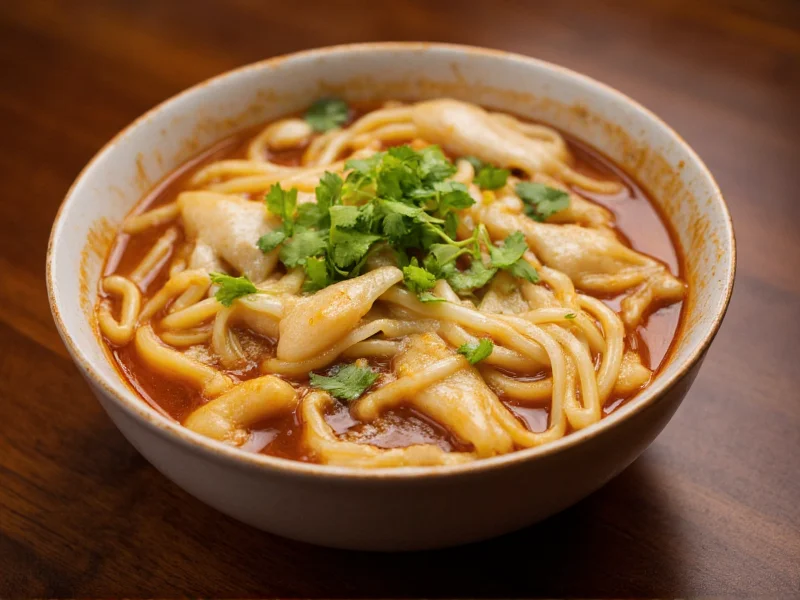Understanding the unique composition of wonton mein soup requires examining its three essential elements. The wontons themselves are delicate parcels made from thin wrappers enclosing seasoned fillings. Traditional fillings include ground pork mixed with shrimp, water chestnuts, and Chinese chives, though vegetarian variations with mushrooms and cabbage have gained popularity. Each wonton is meticulously folded, often in the distinctive 'pouch' style that seals in flavorful juices during cooking.
The 'mein' component refers to Chinese egg noodles, which differ significantly from regular wonton soup that might use thinner noodles or none at all. These wheat-based noodles provide substantial chewiness and absorb broth flavors beautifully. When properly prepared, they maintain their texture without becoming mushy, even when sitting in hot broth. The specific noodle thickness can vary by region—Cantonese versions often use thinner strands while Northern Chinese adaptations might feature thicker, heartier noodles.
| Dish Type | Primary Components | Broth Characteristics | Texture Profile |
|---|---|---|---|
| Wonton Mein Soup | Equal parts wontons and egg noodles | Clear, aromatic broth with ginger notes | Balanced—tender dumplings with chewy noodles |
| Traditional Wonton Soup | Primarily wontons with minimal noodles | Lighter, more delicate broth | Soft dumplings with subtle noodle presence |
| Ramen | Noodles with optional toppings | Rich, cloudy broth (tonkotsu/miso) | Firm noodles with varied topping textures |
The broth serves as the unifying element in authentic wonton mein soup preparation. Chefs typically start with a base of pork or chicken bones simmered for hours to extract maximum flavor and collagen. This foundational stock gets enhanced with aromatics like ginger slices, garlic cloves, and dried shiitake mushrooms. The resulting broth should be clear yet deeply flavorful—never cloudy or greasy. Many home cooks now use simplified versions with quality store-bought stocks, though traditionalists insist homemade broth makes the critical difference between ordinary and exceptional wonton mein soup.
Cultural variations significantly influence how wonton mein soup manifests across different regions. In Hong Kong's dai pai dongs (open-air food stalls), you'll find versions with bok choy and Chinese broccoli adding freshness. American-Chinese interpretations often include additional vegetables like carrots and snap peas, reflecting local produce availability. The dish's evolution demonstrates how immigrant communities adapt traditional recipes while maintaining core elements—a phenomenon culinary historians call 'dish migration.' Understanding these regional adaptations helps appreciate wonton mein soup's journey from humble street food to international comfort cuisine.
When preparing wonton mein soup at home, ingredient quality directly impacts the final result. Freshly made wonton wrappers yield superior texture compared to dried alternatives, while hand-chopped fillings create better mouthfeel than machine-processed versions. The broth's clarity depends on careful skimming during simmering—a technique requiring patience but delivering professional results. For those seeking authentic Chinese wonton mein soup experience, balancing the 'five flavors' (sweet, sour, salty, bitter, umami) remains crucial, often achieved through precise seasoning with soy sauce, rice vinegar, and sesame oil.
Nutritionally, wonton mein soup offers a balanced meal when prepared traditionally. The protein from wonton fillings combines with carbohydrates from noodles and vitamins from broth vegetables. A standard serving contains approximately 300-400 calories, depending on portion sizes and ingredient choices. Health-conscious adaptations might use whole wheat noodles, leaner pork ratios, or incorporate more leafy greens. Unlike many restaurant noodle dishes loaded with sodium, homemade wonton mein soup allows control over salt content while maintaining rich flavor through natural ingredients.
Recognizing authentic wonton mein soup involves several sensory indicators. The broth should have a clean aroma with prominent ginger notes but not overpowering. Wontons must feel plump yet delicate when lifted with chopsticks, showing no signs of bursting. Properly cooked noodles retain slight resistance when bitten ('al dente' in Western terms). Many experienced diners assess quality by the broth's ability to coat the spoon lightly—a sign of proper collagen extraction from bone broth. These subtle markers distinguish exceptional wonton mein soup from mediocre versions that might simply combine pre-made components without culinary intention.
Frequently Asked Questions
What's the difference between wonton soup and wonton mein soup?
Wonton soup primarily features wontons in broth with minimal noodles, while wonton mein soup gives equal importance to both wontons and egg noodles (mein). The 'mein' designation indicates the substantial noodle component that transforms it from a dumpling-focused soup to a complete noodle soup meal.
Are wonton mein soup and wonton noodle soup the same thing?
Yes, wonton mein soup and wonton noodle soup refer to the same dish. 'Mein' is the Chinese term for noodles, so both names describe the combination of wontons and noodles in broth. Regional variations might use slightly different noodle types or wonton fillings, but the core concept remains consistent.
What type of noodles are used in authentic wonton mein soup?
Authentic wonton mein soup uses thin to medium-thickness Chinese egg noodles made from wheat flour and eggs. These noodles provide the characteristic yellow color and springy texture that holds up well in hot broth. Fresh egg noodles are preferred over dried versions for optimal texture, though quality dried alternatives work well when fresh aren't available.
Can wonton mein soup be made vegetarian?
Yes, vegetarian wonton mein soup can be made by using mushroom or vegetable-based broth and filling wontons with ingredients like shiitake mushrooms, tofu, cabbage, and wood ear fungus. The key is maintaining the umami depth typically provided by meat-based ingredients through careful broth preparation with dried mushrooms and kombu seaweed.











 浙公网安备
33010002000092号
浙公网安备
33010002000092号 浙B2-20120091-4
浙B2-20120091-4